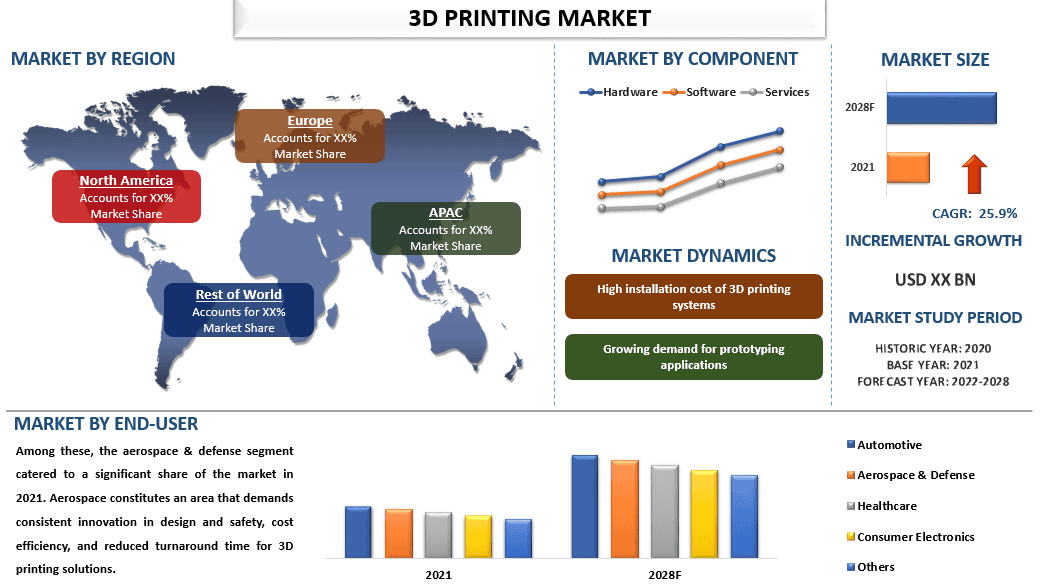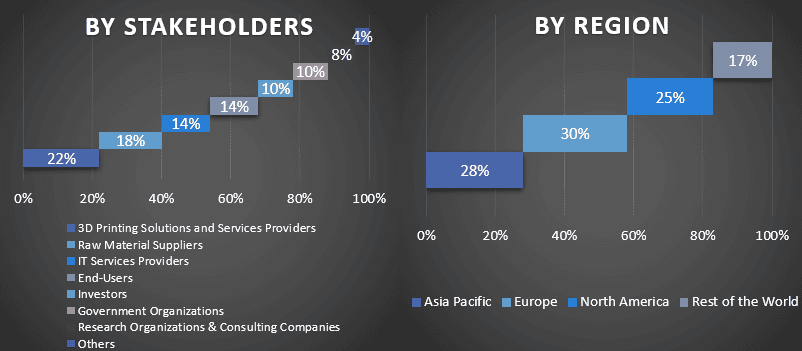- Home
- About Us
- Industry
- Services
- Reading
- Contact Us
3D Printing Market: Current Analysis and Forecast (2022-2028)
Emphasis on Component (Hardware, Software, and Services); Technology (Fuse Deposition Modelling, Selective Laser Sintering, Material Jetting, Stereolithography, and Metal Sintering); Application (Direct Part Production, Fit and Assembly, Functional Models, and Others); End-User (Automotive, Aerospace & Defense, Healthcare, Consumer Electronics, and Others); and Region/Country

The 3D Printing Market is expected to grow at a strong CAGR of 25.9% during the forecast period owing to the growing digitalization and increasing adoption of industry 4.0, robotics, and machine learning. Moreover, the increasing demand for 3D printing is also driven by its long-term cost-effectiveness, customization, speed, flexibility, and sustainability. As technology continues to improve and new applications are discovered, the demand for 3D printing is likely to continue to grow. 3D printing allows for the creation of unique and customized products, which is particularly appealing to consumers who want personalized items. Further on, 3D printing allows for the production of complex shapes and geometries, which can be difficult or impossible to achieve using traditional manufacturing methods. Also, it can reduce waste and the carbon footprint of production, as it only uses the exact amount of material needed to produce a given object.
Some of the major players operating in the market include Stratasys; Materialise; ENVISIONTEC US LLC; 3D Systems, Inc.; GENERAL ELECTRIC; Autodesk Inc.; Canon Inc.; voxeljet AG; HP Development Company, L.P.; and ExOne. Several M&As along with partnerships have been undertaken by these players to facilitate customers with hi-tech and innovative products/technologies.
Insights Presented in the Report
“Amongst technology, the fuse deposition modelling segment held a prominent share of the market in 2021”
By technology, the market is segmented into fuse deposition modelling, selective laser sintering, material jetting, stereolithography, and metal sintering. The fuse deposition modelling segment captured more than 50% share of the 3D Printing market in 2021 owing to the extensive adoption of the technology across various 3D printing processes. Further, the growing demand from aerospace and defense, healthcare, and automotive verticals would open opportunities for the adoption of these technologies.
“Amongst application, the functional model application held a prominent share of the market in 2021”
On the basis of application, the market is classified into direct part production, fit and assembly, functional models, and others. The functional model application held a commendable share of the 3D printing market in 2021 and is expected to grow at a substantial CAGR during the forecasted period due to the rising adoption of the functional modelling process across several industry verticals. The automotive and aerospace and defense verticals particularly use functional models to design and develop parts, components, and complex systems precisely.
“North America dominated the market in 2021”
3D printing technology has gained vastly in prominence over traditional manufacturing methods in North America due to its efficiency and high precision rate. Considering the rapid growth prospects of the region in every aspect, the region continued to dominate the 3D industry in terms of market share in 2021. Furthermore, the growth in the region can also be attributed to efficient utilization of materials, time and cost efficiency, the drastic surge in customization of 3D solutions, and burgeoning technical upgradation coupled with the region’s economic potential to make consistent investments in emerging economies.
Reasons to buy this report:
- The study includes market sizing and forecasting analysis validated by authenticated key industry experts.
- The report presents a quick review of overall industry performance at one glance.
- The report covers an in-depth analysis of prominent industry peers with a primary focus on key business financials, product portfolios, expansion strategies, and recent developments.
- Detailed examination of drivers, restraints, key trends, and opportunities prevailing in the industry.
- The study comprehensively covers the market across different segments.
- Deep dive regional level analysis of the industry.
Customization Options:
The global 3D printing market can further be customized as per the requirement or any other market segment. Besides this, UMI understands that you may have your own business needs, hence feel free to connect with us to get a report that completely suits your requirements.
Table of Content
Research Methodology for the 3D Printing Market Analysis (2022-2028)
Analyzing the historical market, estimating the current market, and forecasting the future market of the global 3D printing market were the three major steps undertaken to create and analyze the adoption of 3D printing in major regions globally. Exhaustive secondary research was conducted to collect the historical market numbers and estimate the current market size. Secondly, to validate these insights, numerous findings and assumptions were taken into consideration. Moreover, exhaustive primary interviews were also conducted, with industry experts across the value chain of the global 3D printing market. Post assumption and validation of market numbers through primary interviews, we employed a top-down/bottom-up approach to forecasting the complete market size. Thereafter, market breakdown and data triangulation methods were adopted to estimate and analyze the market size of segments and sub-segments of the industry pertains to. Detailed methodology is explained below:
Analysis of Historical Market Size
Step 1: In-Depth Study of Secondary Sources:
Detail secondary study was conducted to obtain the historical market size of the 3D printing market through company internal sources such as annual reports & financial statements, performance presentations, press releases, etc., and external sources including journals, news & articles, government publications, competitor publications, sector reports, third-party database, and other credible publications.
Step 2: Market Segmentation:
After obtaining the historical market size of the 3D printing market, we conducted a detailed secondary analysis to gather historical market insights and share for different segments & sub-segments for major regions. Major segments are included in the report as component, technology, application, and end-user. Further country-level analyses were conducted to evaluate the overall adoption of testing models in that region.
Step 3: Factor Analysis:
After acquiring the historical market size of different segments and sub-segments, we conducted a detailed factor analysis to estimate the current market size of the 3D Printing market. Further, we conducted factor analysis using dependent and independent variables such as component, technology, application, and end-user of the 3D printing market. A thorough analysis was conducted for demand and supply-side scenarios considering top partnerships, mergers and acquisitions, business expansion, and product launches in the 3D printing market sector across the globe.
Current Market Size Estimate & Forecast
Current Market Sizing: Based on actionable insights from the above 3 steps, we arrived at the current market size, key players in the global 3D printing market, and market shares of the segments. All the required percentage shares split, and market breakdowns were determined using the above-mentioned secondary approach and were verified through primary interviews.
Estimation & Forecasting: For market estimation and forecast, weights were assigned to different factors including drivers & trends, restraints, and opportunities available for the stakeholders. After analyzing these factors, relevant forecasting techniques i.e., the top-down/bottom-up approach were applied to arrive at the market forecast for 2028 for different segments and sub-segments across the major markets globally. The research methodology adopted to estimate the market size encompasses:
- The industry’s market size, in terms of revenue (USD) and the adoption rate of the 3D printing market across the major markets domestically
- All percentage shares, splits, and breakdowns of market segments and sub-segments
- Key players in the global 3D printing market in terms of products offered. Also, the growth strategies adopted by these players to compete in the fast-growing market
Market Size and Share Validation
Primary Research: In-depth interviews were conducted with the Key Opinion Leaders (KOLs) including Top Level Executives (CXO/VPs, Sales Head, Marketing Head, Operational Head, Regional Head, Country Head, etc.) across major regions. Primary research findings were then summarized, and statistical analysis was performed to prove the stated hypothesis. Inputs from primary research were consolidated with secondary findings, hence turning information into actionable insights.
Split of Primary Participants in Different Regions

Market Engineering
The data triangulation technique was employed to complete the overall market estimation and to arrive at precise statistical numbers for each segment and sub-segment of the global 3D printing market. data was split into several segments & sub-segments post studying various parameters and trends in the areas of the component, technology, application, and end-user in the global 3D printing market.
The main objective of the Global 3D Printing Market Study
The current & future market trends of the global 3D printing market were pinpointed in the study. Investors can gain strategic insights to base their discretion for investments on the qualitative and quantitative analysis performed in the study. Current and future market trends determined the overall attractiveness of the market at a regional level, providing a platform for the industrial participant to exploit the untapped market to benefit from a first-mover advantage. Other quantitative goals of the studies include:
- Analyze the current and forecast market size of the 3D printing market in terms of value (USD). Also, analyze the current and forecast market size of different segments and sub-segments
- Segments in the study include areas of the component, technology, application, and end-user
- Define and analysis of the regulatory framework for the 3D printing industry
- Analyze the value chain involved with the presence of various intermediaries, along with analyzing customer and competitor behaviors of the industry
- Analyze the current and forecast market size of the 3D printing market for the major region
- Major countries of regions studied in the report include Asia Pacific, Europe, North America, and the Rest of the World
- Company profiles of the 3D printing market and the growth strategies adopted by the market players to sustain in the fast-growing market
- Deep dive regional level analysis of the industry
Related Reports
Customers who bought this item also bought










